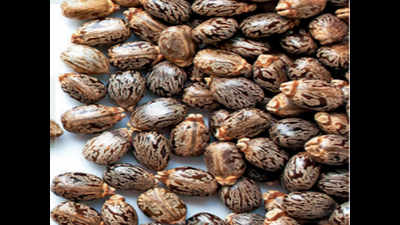- News
- City News
- ahmedabad News
- Castor acreage up 78% from last year
Trending
This story is from August 21, 2019
Castor acreage up 78% from last year
The eventual arrival of monsoon rain and attractive castor prices has led to an increase in the acreage sown with castor in the state

Attractive prices of castor seed and timely arrival of monsoon has pushed up castor cultivation
AHMEDABAD: The eventual arrival of monsoon rain and attractive castor prices has led to an increase in the acreage sown with castor in the state. Compared to the same period in 2018, 78% more land has been sown with the oilseed this year.

The acreage sown with all crops this season is 89.08% of the ten-year average of 84.77 lakh hectares (ha) of arable land in the state.
Data from the agriculture department shows that castor is usually sown on 5.46 lakh ha but till August 19 this year, it had been sown on 3.57 lakh ha, against 1.94 lakh ha at the same point in 2018, which is about 2.4 lakh ha higher.
Castor seed prices have remained attractive throughout the year. Castor prices at present around Rs 1,100 per 20kg, which was around Rs 800 to Rs 900 per 20kg at the same point last year, industry sources said. The higher prices are largely attributed to lower production of the oilseed in 2018-19. Production in India was estimated to be 11.26 lakh tonnes as compared to 14.16 lakh tonnes in 2017-18. “Against this, our requirement was around 16 lakh tonnes. Reduced production also brought down the carry-forward stock for the ongoing season as well. This has pushed up castor seed prices,” added B V Mehta, executive director, SEA.Moreover, in 2018-19, the total area under castor cultivation in the state had fallen by 10%, to 5.34 lakh hectares, from 5.91 lakh hectares in 2016-2017. Experts attribute this year’s higher acreage to the fact that Gujarat had got scanty rains last year and a large proportion of arable land had remained uncultivated.
“Farmland not used for cultivation due to the scanty rains last year has now come under castor cultivation,” Mehta added.
The SEA is working closely along with farmers to raise the acreage under castor and production. SEA has set up 300 model farms in Gujarat and Rajasthan. These farms have already started showing results. Moreover, the national body for the vegetable oil industry has also taken up water harvesting initiatives in Amreli and Junagadh districts, where farmers are being provided a 50% cost incentive .

The acreage sown with all crops this season is 89.08% of the ten-year average of 84.77 lakh hectares (ha) of arable land in the state.
Data from the agriculture department shows that castor is usually sown on 5.46 lakh ha but till August 19 this year, it had been sown on 3.57 lakh ha, against 1.94 lakh ha at the same point in 2018, which is about 2.4 lakh ha higher.
The authorities said castor sowing will pick up by the end of August and in September. Farmers usually opt to sow castor relatively late in the season. “The attractive castor prices coupled with the timely rain has encouraged farmers to opt for castor cultivation. This has resulted in a spurt in the castor acreage,” said Haresh Vyas, co-chairman of the castor seed and oil promotion council of the Solvent Extractors’ Association (SEA).
Castor seed prices have remained attractive throughout the year. Castor prices at present around Rs 1,100 per 20kg, which was around Rs 800 to Rs 900 per 20kg at the same point last year, industry sources said. The higher prices are largely attributed to lower production of the oilseed in 2018-19. Production in India was estimated to be 11.26 lakh tonnes as compared to 14.16 lakh tonnes in 2017-18. “Against this, our requirement was around 16 lakh tonnes. Reduced production also brought down the carry-forward stock for the ongoing season as well. This has pushed up castor seed prices,” added B V Mehta, executive director, SEA.Moreover, in 2018-19, the total area under castor cultivation in the state had fallen by 10%, to 5.34 lakh hectares, from 5.91 lakh hectares in 2016-2017. Experts attribute this year’s higher acreage to the fact that Gujarat had got scanty rains last year and a large proportion of arable land had remained uncultivated.
“Farmland not used for cultivation due to the scanty rains last year has now come under castor cultivation,” Mehta added.
The SEA is working closely along with farmers to raise the acreage under castor and production. SEA has set up 300 model farms in Gujarat and Rajasthan. These farms have already started showing results. Moreover, the national body for the vegetable oil industry has also taken up water harvesting initiatives in Amreli and Junagadh districts, where farmers are being provided a 50% cost incentive .
End of Article
FOLLOW US ON SOCIAL MEDIA










